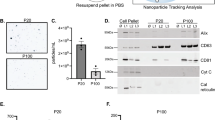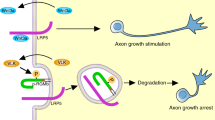Abstract
Neurturin (NTN)1 is a recently identified homologue of glial-cell-line-derived neurotrophic factor (GDNF)2. Both factors promote the survival of a variety of neurons1,2,3,4,5, and GDNF is required for the development of the enteric nervous system and kidney6,7,8. GDNF signals through a receptor complex consisting of the receptor tyrosine kinase Ret and a glycosyl-phosphatidylinositol (GPI)-linked receptor termed GDNFR-α9,10,11,12,13. Here we report the cloning of a new GPI-linked receptor termed NTNR-α that is homologous with GDNFR-α and is widely expressed in the nervous system and other tissues. By using microinjection to introduce expression plasmids into neurons, we show that coexpression of NTNR-α with Ret confers a survival response to neurturin but not GDNF, and that coexpression of GDNFR-α with Ret confers a survival response to GDNF but not neurturin. Our findings indicate that GDNF and neurturin promote neuronal survival by signalling through similar multicomponent receptors that consist of a common receptor tyrosine kinase and a member of a GPI-linked family of receptors that determines ligand specificity.
This is a preview of subscription content, access via your institution
Access options
Subscribe to this journal
Receive 51 print issues and online access
$199.00 per year
only $3.90 per issue
Buy this article
- Purchase on Springer Link
- Instant access to full article PDF
Prices may be subject to local taxes which are calculated during checkout




Similar content being viewed by others
References
Kotzbauer, P. T.et al. Neurturin, a relative of glial-cell-line-derived neurotrophic factor. Nature 384, 467–470 (1996).
Lin, L. H., Doherty, D. H., Lile, J. D., Bektesh, S. & Collins, F. GDNF: A glial cell-derived neurotrophic factor for midbrain dopaminergic neurons. Science 260, 1130–1132 (1993).
Henderson, C. E.et al. GDNF: A potent survival factor for motoneurons present in peripheral nerve and muscle. Science 266, 1062–1064 (1994).
Buj-Bello, A., Buchman, V. L., Horton, A., Rosenthal, A. & Davies, A. M. GDNF is an age-specific survival factor for sensory and autonomic neurons. Neuron 15, 821–828 (1995).
Trupp, M.et al. Peripheral expression and biological activities of GDNF, a new neurotrophic factor for avian and mammalian peripheral neurons. J. Cell Biol. 130, 137–148 (1995).
Moore, M. W.et al. Renal and neuronal abnormalities in mice lacking GDNF. Nature 382, 76–79 (1996).
Pichel, J. G.et al. Defects in enteric innervation and kidney development in mice lacking GDNF. Nature 382, 73–76 (1996).
Sanchez, M. P.et al. Renal agenesis and the absence of enteric neurons in mice lacking GDNF. Nature 382, 70–73 (1996).
Treanor, J.et al. Characterization of a receptor for glial cell line-derived neurotropic factor. Nature 382, 80–83 (1996).
Jing, S.et al. GDNF-induced activation of the ret protein tyrosine kinase is mediated by GDNFR-α, a novel receptor for GDNR. Cell 85, 1113–1124 (1996).
Trupp, M.et al. Functional receptor for GDNF encoded by the c-ret proto-oncogene. Nature 381, 785–789 (1996).
Durbec, P.et al. GDNF signalling through the Ret receptor tyrosine kinase. Nature 381, 789–793 (1996).
Vega, Q. C., Worby, C. A., Lechner, M. S., Dixon, J. E. & Dressler, G. R. Glial cell line-derived neurotrophic factor activates the receptor tyrosine kinase RET and promotes kidney morphogenesis. Proc. Natl Acad. Sci. USA 93, 10657–10661 (1996).
Gerber, L. D., Kodukula, K. & Udenfried, S. Phosphatidylinositol glycan (PI-G) anchored membrane proteins. Amino acid requirements adjacent to the site of cleavage and PI-G attachment in the COOH-terminal signal peptide. J. Biol. Chem. 267, 12168–12173 (1992).
Davis, S.et al. LIFRβ and gp130 as heterodimerizing signal transducers of the tripartite CNTF receptor. Science 260, 1805–1808 (1993).
Koke, J. A., Yang, M., Henner, D. J., Volwerk, J. J. & Griffin, O. H. High-level expression in Escherichia coli and rapid purification of phosphatidylinositol-specific phospholipase C from Bacillus cereus and Bacillus thuringiensis. Protein Expr. Purif. 2, 51–58 (1991).
Klein, R.et al. The trkB tyrosine protein kinase is a receptor for brain-derived neurotrophic factor and neurotrophin-3. Cell 66, 395–403 (1991).
Klein, R. D.et al. AGPI-linked protein that interacts with Ret to form a candidate neurturin receptor. Nature 387, 717–721 (1997).
Lee, J. D.et al. Glycosyl-phosphatidylinositol-anchored or integral membrane forms of CD14 mediate identical cellular responses to endotoxin. Proc. Natl Acad. Sci. YSA 90, 9930–9934 (1993).
Pugin, J.et al. Lipopolysaccharide activation of human endothelial and epithelial cells is mediated by lipopolysaccharide-binding protein and soluble CD14. Proc. Natl Acad. Sci. USA 90, 2744–2747 (1993).
Baka, I. D.et al. Intracellular compartmentalisation of two differently spliced S-REX/NSP mRNAs in neurons. Mol. Cell Neurosci. 7, 289–303 (1996).
Ninkina, N.et al. Expression and function of TrkB variants in developing sensory neurons. EMBO J. 15, 6385–6393 (1996).
Davies, A. M., Minichiello, L. & Klein, R. Developmental changes in NT3 signalling via TrkA and TrkB in embryonic neurons. EMBO J. 14, 4482–4489 (1995).
Allsopp, T. E., Wyatt, S., Paterson, H. F. & Davies, A. M. The proto-oncogene bcl-2 can selectively rescue neurotrophic factor-dependent neurons from apoptosis. Cell 73, 295–306 (1993).
Buj-Bello, A., Pinon, L. G. & Davies, A. M. The survival of NGF-dependent but not BDNF-dependent cranial sensory neurons is promoted by several different neurotrophins early in their development. Development 120, 1573–1580 (1994).
Acknowledgements
We thank H. Philips, R. Klein, R. Vandlen, B. Moffet and L. Simmons for the purified recombinant GDNF and neurturin; J. Winslow and G. Burdon for the purified recombinant BDNF; and D. Roche and J. Allan for preparing the illustrations. This work was supported by Action Research and the Wellcome Trust.
Author information
Authors and Affiliations
Corresponding author
Supplementary Information
Rights and permissions
About this article
Cite this article
Buj-Bello, A., Adu, J., Piñón, L. et al. Neurturin responsiveness requires a GPI-linked receptor and the Ret receptor tyrosine kinase. Nature 387, 721–724 (1997). https://doi.org/10.1038/42729
Received:
Accepted:
Issue Date:
DOI: https://doi.org/10.1038/42729
This article is cited by
-
Improving therapeutic potential of GDNF family ligands
Cell and Tissue Research (2020)
-
Connecting rules from paired miRNA and mRNA expression data sets of HCV patients to detect both inverse and positive regulatory relationships
BMC Genomics (2015)
-
Ret-Dependent and Ret-Independent Mechanisms of Gfl-Induced Sensitization
Molecular Pain (2011)
-
RET and neuroendocrine tumors
Pituitary (2006)
-
Immunohistochemical expression of two members of the GDNF family of growth factors and their receptors in the olfactory system
Journal of Neurocytology (2005)
Comments
By submitting a comment you agree to abide by our Terms and Community Guidelines. If you find something abusive or that does not comply with our terms or guidelines please flag it as inappropriate.



